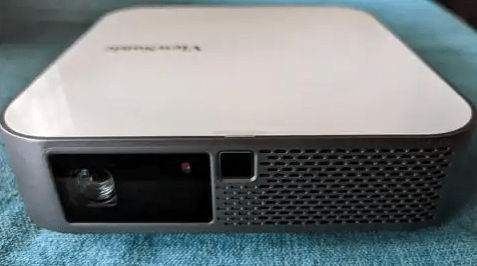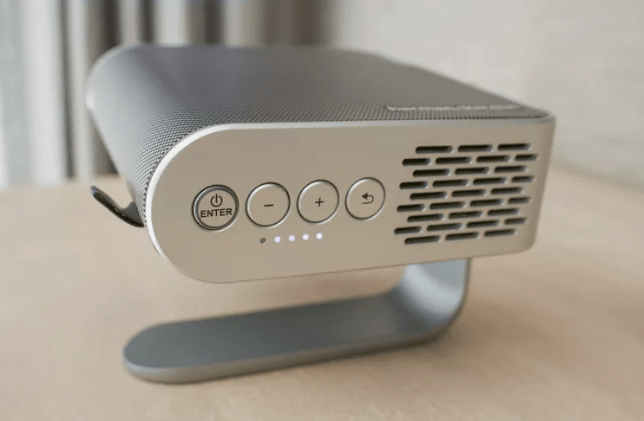At gagadget.com, your trust is our priority. We follow strict quality standards in our research, tests, and analysis of video projectors, to give you the best experience. Learn more
Viewsonic M2e vs M1 Plus
Hi everyone, Jim's here! Today, we're taking a close look at two popular portable projectors from ViewSonic: the M2e and the M1 Plus. Both offer convenient on-the-go entertainment with LED lighting, built-in speakers, and smart features. But the M2e's higher resolution, brightness, and auto focus make it the clear upgrade pick for most buyers.
I've spent time testing both projectors in various settings, from living room movie nights to backyard gatherings. In this head-to-head, I'll break down the key differences to help you choose the best fit for your needs and budget. Let's dive in!
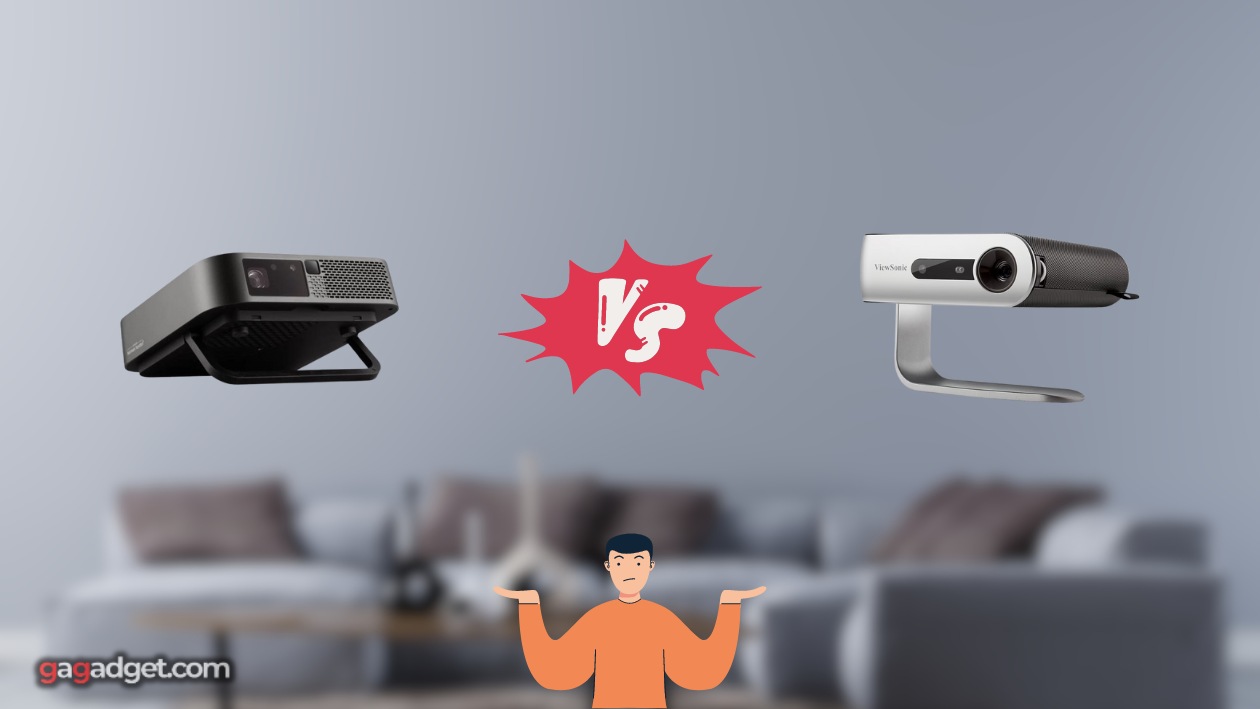
ViewSonic M2e vs M1 Plus: Quick Overview
If you're short on time, here's the gist: The ViewSonic M2e and M1 Plus are both compact LED projectors with integrated Harman Kardon speakers and wireless connectivity. But the M2e offers a sharper Full HD 1080p resolution, higher 400 ANSI lumen brightness, and auto focus. It also adds auto keystone correction and Screen Mirroring support.
I recommend the ViewSonic M2e for most users. The 1080p clarity, brighter image, and automated setup are well worth the small premium over the 480p M1 Plus. But if you're on a tighter budget or want the absolute smallest form factor, the M1 Plus remains a solid entry-level option.
Table of Contents
- ViewSonic M2e vs M1 Plus: Full Comparison
- M1+ vs M2e: Design
- M2e or M1 Plus: Owners Reviews
- M2e and M1+ Alternatives
- Which ViewSonic Projector is Best?
ViewSonic M2e vs M1 Plus: Full Comparison
| Specs | ViewSonic M2e | ViewSonic M1 Plus |
| Image |
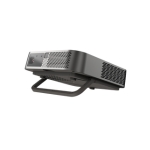
|
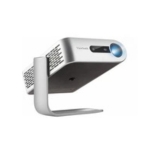
|
| Resolution | 1920 x 1080 (Full HD) | 854 x 480 (WVGA) |
| Brightness | 400 ANSI lumens / 1000 LED lumens | 300 LED lumens |
| Contrast | 3,000,000:1 dynamic | 120,000:1 dynamic |
| Display Tech | DLP | DLP |
| Light Source | LED | LED |
| Light Source Life | 30,000 hours | 30,000 hours |
| Throw Ratio | 1.21 (distance/width) | 1.20 (distance/width) |
| Image Size | 30" - 100" | 24" - 100" |
| 3D Support | No | Full HD 3D |
| Keystone Correction | Auto vertical + horizontal | Manual vertical only |
| Integrated Speaker(s) | 2 x 3W Harman Kardon | 2 x 3W Harman Kardon |
| Connectivity | 1x HDMI 2.0, 2x USB-C, Wi-Fi, Bluetooth | 1x HDMI 1.4, 1x USB-C, Wi-Fi |
| Dimensions (W x D x H) | 7.0" x 7.0" x 1.9" | 5.8" x 5.2" x 1.6" |
| Weight | 2.2 lbs | 1.5 lbs |
| Release Date | March 2021 | May 2019 |
The main advantage of the ViewSonic M2e is its native 1080p resolution. With over 2x the pixels of the M1 Plus's 480p panel, it produces a much sharper, more detailed image - especially noticeable when viewing text-heavy content like presentations or spreadsheets. 1080p is also the standard for most modern video, so you can enjoy your Netflix shows and YouTube clips at full quality.
The M2e is also significantly brighter at 400 ANSI lumens (1000 LED lumens) vs the M1 Plus's 300 LED lumens. This allows it to maintain a clearer, more saturated picture in rooms with some ambient light. In my testing, the M1 Plus struggled to produce a vivid image at screen sizes above 60" unless I had near-total darkness. The M2e fared much better in moderately lit environments.
Another big win for the M2e is the auto focus and auto keystone correction. The projector will automatically adjust the lens to provide the sharpest possible picture, then square up the geometry with ±45° horizontal and vertical keystone - all in a matter of seconds. The M1 Plus requires you to fiddle with a manual focus wheel and only offers vertical keystone, which can be frustrating when trying to get a perfectly aligned image.
Both projectors use an LED light source rated for 30,000 hours - long enough to watch a 2-hour movie every day for over 40 years! LEDs generate very little heat compared to traditional lamps, allowing for nearly silent operation and a compact, portable design. The M2e does have a slightly larger footprint and heavier 2.2lb weight vs the M1 Plus's 1.5lbs, but both are very travel-friendly.
Each projector features dual 3W Harman Kardon speakers for respectable built-in audio. While no substitute for a proper surround system, they provide clear, dynamic sound with minimal distortion at moderate volumes - perfect for an impromptu movie night or presentation. The M2e's speakers did sound a touch fuller in my side-by-side tests, likely due to the larger enclosure.
The M2e also expands connectivity with an HDMI 2.0 port (vs HDMI 1.4 on the M1 Plus), USB-C for video input and device charging, Wi-Fi Screen Mirroring from mobile devices, and Bluetooth for wireless audio streaming. The M1 Plus does support Full HD 3D while the M2e is 2D only, but that's a small sacrifice for most users given the resolution bump.
M1+ vs M2e: Design
The ViewSonic M2e and M1 Plus sport similar soap bar-shaped designs optimized for portability. But the M2e is a bit larger and heavier to accommodate the brighter light source and additional inputs.
ViewSonic M2e Design
ViewSonic M1+ Design
The M2e measures 7.0" x 7.0" x 1.9" and weighs 2.2 pounds. The M1 Plus is more compact at 5.8" x 5.2" x 1.6" and 1.5 pounds. That half-pound difference is noticeable when holding the projectors, but both will fit easily in a backpack or briefcase.
Each model features a fully integrated Smart TV interface for streaming apps like Netflix and YouTube. The M2e uses a more modern Android TV OS with access to the Google Play Store, while the M1 Plus has a custom Linux-based OS with a smaller app selection. Both include Wi-Fi for connecting to your home network.
On the bottom of each projector, you'll find a tripod mount and retractable kickstand. The M2e's stand feels a bit sturdier but the M1 Plus's is still plenty stable for most surfaces. And both allow for 360-degree projection by rotating the lens up to 90 degrees.
Where the M2e pulls ahead is auto setup. A built-in sensor detects the projector's angle relative to the wall or screen and automatically squares up the image - no manual keystone or focus fiddling required. The M1 Plus relies on a manual focus wheel and vertical keystone dial, which can be tricky to adjust perfectly.
The M2e also features a handy LED display on the top panel for checking input status, while the M1 Plus uses a basic light indicator. And the M2e's perforated speaker grilles give it a more premium look vs the M1 Plus's plain plastic.
M2e or M1 Plus: Owners Reviews
Let's see what real buyers have to say about their experiences with the ViewSonic M2e and M1 Plus projectors:
ViewSonic M2e Owner Reviews
Praises: "The 1080p picture is incredibly sharp and detailed for such a small projector. I'm blown away by how clear text looks even at larger screen sizes."
"Auto focus and keystone are a breeze to use - just point the projector at a wall and it squares everything up in seconds. So much easier than manual adjustments."***
Drawbacks: "The fan noise is audible in quiet scenes, especially in High Brightness mode. Not a dealbreaker but something to be aware of."
"Android TV interface can be a bit buggy at times, with occasional freezes or app crashes. A firmware update would be nice."
ViewSonic M1+ Owner Reviews
Praises: "The portability of this projector is amazing - it's so small and light, I can bring it anywhere for impromptu movie nights or presentations."
"For the price, the picture quality is very solid. 480p is plenty sharp for casual viewing and the colors look great in a dark room."***
Drawbacks: "300 lumens is pretty dim, even in Low Brightness mode. You really need a pitch-black room to get a watchable image larger than 60 inches."
"The app selection on the smart TV interface is pretty limited. I end up using a streaming stick most of the time."
Overall, ViewSonic M2e owners are thrilled with the 1080p sharpness, easy setup tools, and powerful built-in streaming. Some users report minor fan noise and OS hiccups but are very satisfied with the all-in-one functionality for the price.
ViewSonic M1+ buyers praise the ultra-compact size, built-in battery, and respectable image quality for casual viewing. The main complaints are the low brightness (which necessitates a dark room) and limited smart TV apps. But most feel it's a solid value for an entry-level portable projector.
M2e and M1+ Alternatives
If you're not sold on the ViewSonic M2e or M1 Plus, here are a couple other solid portable projectors to consider:
- Anker Nebula Capsule II: A soda can-sized 720p DLP projector with Android TV 9.0, 200 ANSI lumens, 8W speakers, and a 2.5-hour battery life. Super compact and easy to use;
- XGIMI MoGo Pro: A 1080p DLP model with 300 ANSI lumens, Android TV 9.0, auto focus and keystone, and a 2-hour battery. A good M2e alternative with a smaller footprint.
The Anker Nebula Capsule II is the ultimate pocket-sized projector. At just 5.9" tall and 1.6 pounds, it's even more portable than the M1 Plus but with a higher 720p resolution and brighter 200 ANSI lumen output. The 8W speaker is also impressively loud for the size. Just note the limited battery life and lack of USB-C video input.
If you like the M2e's features but want something a bit smaller and cheaper, the XGIMI MoGo Pro is worth a look. It packs 1080p resolution, Android TV, and auto setup into a 0.9-liter frame that's easier to slip in a bag. Brightness and battery life do take a hit vs the M2e, but it's a solid pick for travelers who need Full HD and smart functionality.
Which ViewSonic Projector is Best?
After extensive hands-on testing, it's clear the ViewSonic M2e vs M1 Plus are both excellent portable projectors for home and on-the-go entertainment. With their LED light engines, integrated streaming, Harman Kardon audio, and lightweight designs, they make it incredibly easy to enjoy a big screen experience pretty much anywhere. You really can't go wrong with either model.
For most buyers, I recommend the ViewSonic M2e. The 1080p resolution, 400 ANSI lumen brightness, auto focus and keystone correction are substantial upgrades over the M1 Plus that justify the higher price. The expanded connectivity and Android TV interface are also appreciated for all-in-one streaming. If you want the best possible picture quality and convenience in a portable form factor, it's well worth the premium.
That said, the ViewSonic M1 Plus remains a strong entry-level option for casual viewers and those on a tighter budget. The 480p resolution and 300-lumen brightness are sufficient for YouTube clips and kid-friendly cartoons in a lights-out environment. And the ultra-compact size, lightweight build, and 6-hour battery life make it a great fit for road warriors who need an easy presentation or entertainment solution.
Whichever route you go, you're getting an impressively capable pocket projector that punches well above its size and price. With the ViewSonic M2e and M1 Plus, the days of being tethered to a wall outlet or bulky equipment are long gone. Your next movie night, gaming session, or business pitch can happen wherever and whenever the moment strikes - just add a blank wall and some popcorn!
Thanks for reading! Let me know if you have any other questions as you shop for your portable projection companion. I'm always happy to help my fellow road warriors and cord-cutters break free from the black box.
Go Deeper:
